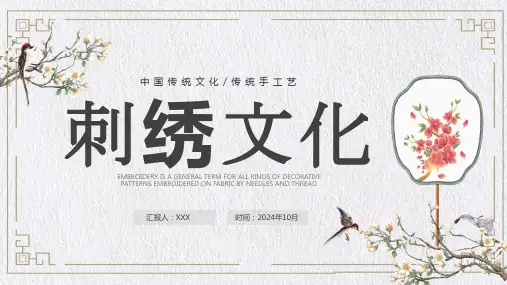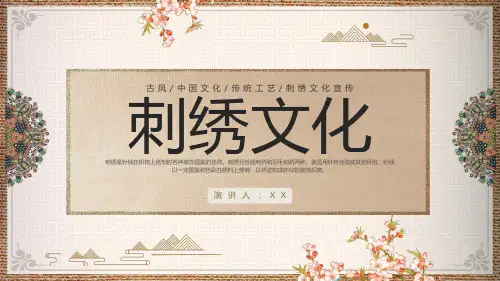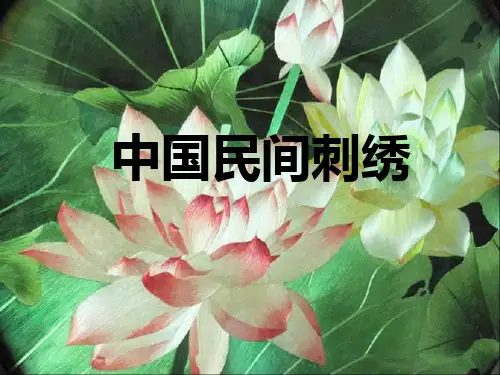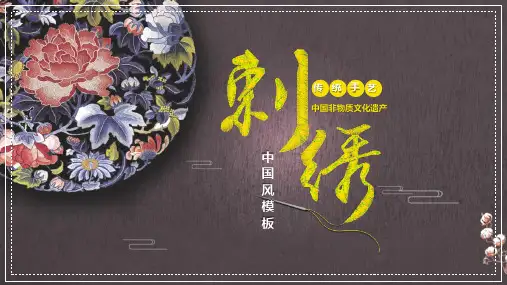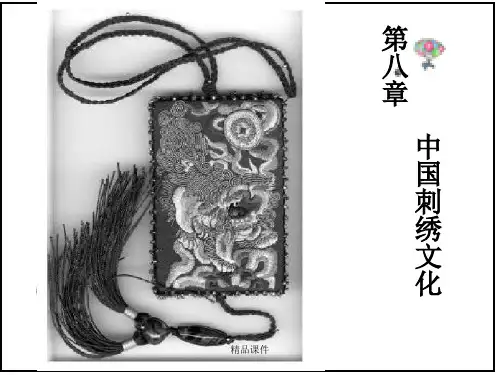- 1、下载文档前请自行甄别文档内容的完整性,平台不提供额外的编辑、内容补充、找答案等附加服务。
- 2、"仅部分预览"的文档,不可在线预览部分如存在完整性等问题,可反馈申请退款(可完整预览的文档不适用该条件!)。
- 3、如文档侵犯您的权益,请联系客服反馈,我们会尽快为您处理(人工客服工作时间:9:00-18:30)。
湘绣以其悠久的历史而闻名,它工艺精湛且风格 独特。最早的湘绣作品是在长沙的汉代墓马王 堆1号 墓出土的。运用的织造技术几乎与现代相同,说明 在汉代刺绣已经存在。在其以后的发展,湘绣吸收了 中国传统绘画的特征,形成了自己独特的魅力。湘绣的全盛 时期在清末(1644-1911)和中华民国早期(二十世纪初),甚 至超越了苏绣。
• Embroidery, a folk art with a long tradition, has an important position in the history of Chinese arts and crafts. • 刺绣,具有悠久的传统民间艺术,在中国工艺美术史上的重要地位。 • China was the first country in the world to weave silk. Silkworms were domesticated as early as some 5,000 years ago. The production of silk threads and fabrics gave rise to the art of embroidery. In 1958, a piece of silk embroidered with a dragon and phoenix was discovered in a state of Chu tomb of the Warring Sates Period (475-221BC). It is the earliest piece of Chinese embroidery ever unearthed. Embroidery became widespread during the Han Dynasty (206BC-AD220) and many embroidered pieces discovered date back to that period. • 中国是世界上第一个国家纺织丝绸。家蚕驯化早在 5000年前。丝线和织物的生产产生了刺绣艺术。 1958年,一块丝绸绣以龙凤在楚墓的战国时期 (公元前475-221年)发现。它是中国最早的 绣片曾出土。在汉代刺绣成为普遍,并且许多绣片 可以追溯到这一时期。
• •
•
图片必须是连贯的。双面绣是苏绣 的典型代表。
In addition to the four major embroidery styles there are Ou embroidery of Wenzhou, Zhejiang Province; Bian embroidery of Kaifeng, Henan Province and Han embroidery of Wuhan, Hubei Province. • 除了四大刺绣,还有浙江 省温州的瓯绣;河南省开 封的汴绣,河南省和湖北 省武汉的汉绣。
• Today, silk embroidery is practiced nearly all over China. The Four Famous Embroideries of China refer to the Xiang embroidery in central China's Hunan Province, Shu embroidery in western China's Sichuan Province, Yue embroidery in southern China's Guangdong Province and Su embroidery in eastern China's Jiangsu Province.
Thank you•Fra bibliotek••
Yue Embroidery
• products of the regions of Guangzhou, Shantou, Zhongshan, Fanyu and Shunde in Guangdong Province. According to historical records, in the first year of Yongzhen's reign (805) during the Tang Dynasty , a girl named Lu Meiniang embroidered the seventh volume of the Fahua Buddhist Scripture on a piece of thin silk 30 cm long. And so, Yue embroidery became famous around the country. 又称广绣,粤绣是广东省番禺和顺德,广州,汕头, 中山地区的刺绣产品的总称。据史料记载,在唐朝永 贞元年(805),一个名叫卢眉娘的女孩将法华经第 七卷绣在一张长30厘米的薄丝上。因此,粤绣举国 闻名。 Influenced by national folk art, Yue embroidery formed its own unique characteristics. The embroidered pictures are mainly of dragons and phoenixes, and flowers and birds, with neat designs and strong, contrasting colors. 在民族民间艺术的影响,粤绣形成了自己独特的特点。 刺绣的图片主要是龙凤,花卉和鸟类,灵巧的设计和 颜色形成强烈对比。
•
•
•
Su Embroidery
• With a history of more than 3,000 years, Su embroidery is the general name for embroidery products in areas around Suzhou, Jiangsu Province. The craft, which dates back to the Three Kingdoms Period (220-280)。 苏绣有3000多年的历史,是江苏苏州周 围的刺绣产品的总称。其工艺可追溯到 三国时期。 Su embroidery features a strong, folk flavor and its weaving techniques are characterized by the following: the product surface must be flat, the rim must be neat, the needle must be thin, the lines must be dense, the color must be harmonious and bright and the picture must be even. Doublesided embroidery is an excellent representative of Su embroidery. 苏绣的特点是强烈的,具有民间风味的; 其织造技术具有以下特点:产品表面必 须平整,边缘要整齐,针要薄,线必须 致密,颜色必须是和谐的,明亮且
• • • • • •
Shu Embroidery
• Also called Chuan embroidery, Shu embroidery is the general name for embroidery products in areas around Chengdu, Sichuan Province. Shu embroidery enjoys a long history. As early as the Han Dynasty, Shu embroidery was already famous. In the mid-Qing Dynasty, the Shu embroidery industry was formed. 也被称为川绣,蜀绣是在四川成都周围地区的 刺绣产品的总称。蜀绣的生产具有悠久的历史。 早在汉代,蜀绣就已经成名。清代中期,蜀绣 产业正式形成。 Originating among the folk people in the west of Sichuan Province, Shu embroidery formed its own unique characteristics: smooth, bright, neat and influenced by the geographical environment, customs and cultures. Altogether, there are 122 approaches in 12 categories for weaving. 蜀绣原产于四川省西部民间,有自己独特的特 点:光滑,明亮,整洁,并受地理环境,风俗 和文化的影响。在纺织方面它共分为12大类, 有122种方法。
• 今天,丝绸刺绣的足迹几乎遍布中 国。中国的四大名绣是中国中部湖 南省的湘绣,中国西部四川省的蜀 绣,中国华南广东省的粤绣,中国 东部江苏省的苏绣。
Xiang Embroidery
• Xiang embroidery is well known for its time-honored history, excellent craftsmanship and unique style. The earliest piece of Xiang embroidery was unearthed at the No 1 Tomb of Mawangdui, Changsha City of the Han Dynasty (206BCAD220). The weaving technique was almost the same as the one used in modern times, which demonstrated that embroidery had already existed in the Han Dynasty. In its later development, Xiang Embroidery absorbed the characteristics of traditional Chinese paintings and formed its own unique characteristics. Xiang embroidery experienced its heyday at the end of the Qing Dynasty (1644-1911) and in the early Republic of China (early 20th century), even surpassing Su embroidery.

